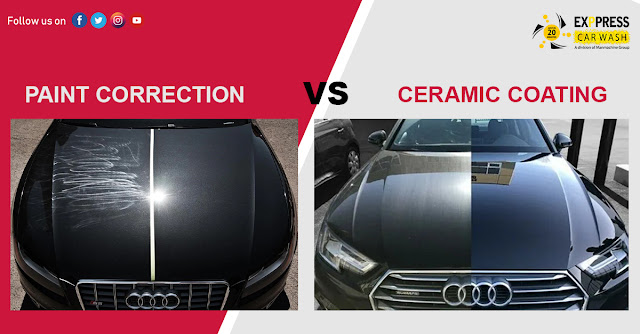The Key Differences Between Paint Correction and Ceramic Coating
Car detailing is an important part of car maintenance, and there are several services that fall under this category. Two of the most popular and sought-after services are paint correction and ceramic coating. While both services aim to enhance the appearance and protect the paint of a car, they are different in terms of their approach and the results they provide. In this blog, we will discuss the difference between paint correction and ceramic coating.
Ceramic Coating:
Ceramic coating is a process that involves applying a liquid polymer to the surface of a car's paint. The coating chemically bonds with the paint to create a protective layer that is much harder and more durable than the car's original clear coat. This protective layer helps to prevent damage from UV rays, environmental contaminants, and other elements that can cause the car's paint to fade, chip, or scratch.
Ceramic coating is a relatively new technology that has gained popularity in recent years due to its long-lasting protection and ease of maintenance. The process of applying ceramic coating involves thoroughly cleaning and preparing the surface of the car's paint and then applying the coating using specialized tools and techniques. Once the coating is applied, it must be allowed to cure for a specific period of time before it can be exposed to the elements.
The result of ceramic coating is a car that looks and feels like it just came off the showroom floor. The coating creates a deep, glossy shine that enhances the colour and clarity of the car's paint. It also provides long-lasting protection against scratches, chips, fading, and other forms of damage. Additionally, ceramic coating is much easier to maintain than traditional wax or sealant coatings, as it does not require frequent reapplication and can be washed with regular car wash soap.
Paint Correction:
Paint correction is a process that involves removing imperfections from the paint of a car, such as scratches, swirl marks, and other minor defects. These imperfections can make the car's paint look dull and lackluster, and they can also reduce the car's value over time. The process of paint correction involves using specialized tools and techniques to carefully remove a thin layer of the car's clear coat, which is the top layer of paint that protects the color layer underneath.
Paint correction is a time-consuming and labor-intensive process that requires the skill and expertise of a professional detailer. The detailer will carefully assess the condition of the car's paint and determine the best approach for correcting any imperfections. They will then use a variety of tools, such as a dual-action polisher and various grades of polishing pads and compounds, to gently remove the imperfections and restore the paint to its original shine.
The result of paint correction is a car that looks brand new, with a glossy and smooth finish. However, it's important to note that paint correction does not provide any protection against future damage or wear and tear. The car's paint is still vulnerable to scratches, chips, and fading from exposure to the sun and other elements.
The Key Differences:
The key difference between paint correction and the ceramic coating is the approach and the results they provide. Paint correction is a process that aims to restore the car's paint to its original condition by removing imperfections, while the ceramic coating is a process that aims to protect the car's paint from future damage and wear and tear.
Another important difference between the two services is the level of skill and expertise required to perform them. Paint correction is a highly specialized skill that requires years of experience and training to master. It is also a time-consuming and labor-intensive process that can take several hours to complete. Ceramic coating, on the other hand, is a relatively simple process that can be performed by a trained professional in a matter of hours.
Conclusion
Both paint correction and ceramic coating are valuable services that can help to enhance the appearance and protect the paint of a car. Paint correction is a process that involves removing imperfections from the paint of a car, while the ceramic coating is a process that involves applying a protective layer to the surface of the car's paint. While paint correction is a highly specialized skill that requires the expertise of a professional detailer, ceramic coating is a relatively simple process that can be performed by a trained professional. Ultimately, the choice between paint correction and ceramic coating will depend on the condition of the car's paint and the level of protection that is desired. Regardless of which service is chosen, both paint correction and ceramic coating can help to extend the life of a car's paint and enhance its appearance for years to come.




0 Comments